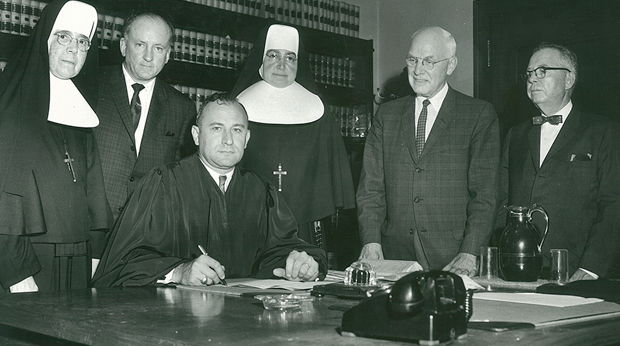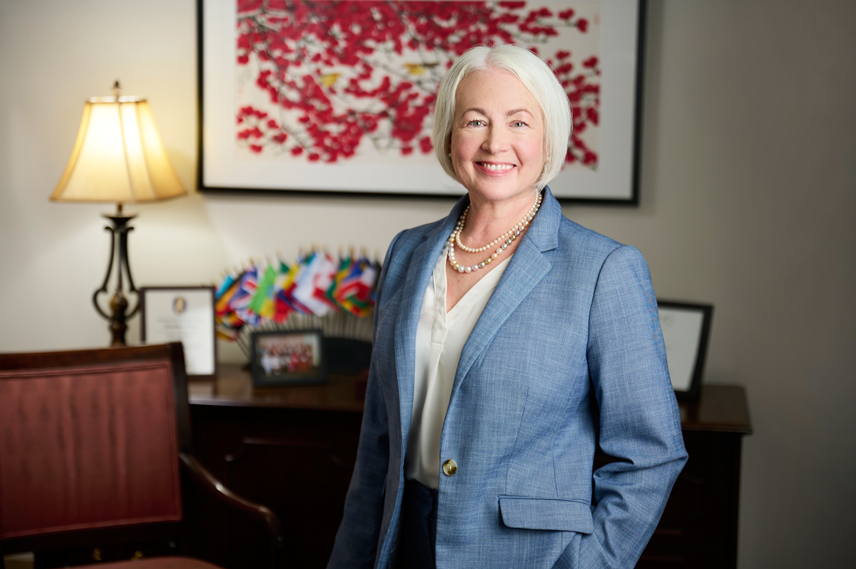
History of LRU
La Roche University was founded on June 27, 1963 by the Congregation of Divine Providence as an independent, private, Catholic college for religious sisters.
The University is named for Marie de la Roche, a French woman of noble birth who became the first superior of the Congregation. The La Roche logo, the fleur-de-lis, is part of her family’s coat of arms.
From its initial role as a college for religious sisters to its current incarnation as an institution for students from around the world, La Roche offers quality educational opportunities that reflect its Catholic heritage and the dynamism and spirit of its founding and sponsoring congregation. Sister Annunciata Sohl, CDP, was appointed the first president of La Roche and served until 1968.
By 1965, the University admitted its first lay students and conferred degrees on its first seven graduates, all members of the Sisters of Divine Providence. Two years later, to accommodate its growing enrollment, the University expanded beyond its leased space to construct its first building, the John J. Wright Library, named for John Cardinal Wright, the eighth bishop of the Diocese of Pittsburgh. At the time, the $1 million library was a state-of-the-art facility among college libraries. By 1969, La Roche admitted male students.
Early Challenges
As is often the case with new institutions, La Roche encountered financial difficulties soon after its founding. The Congregation gave serious consideration to closing the University. However, the institution had already made such an impact on the community that students, community leaders and state officials urged the Congregation and Sister de la Salle Mahler, CDP, college president from 1969-1975, to give it another chance.
Responding to this outpouring of support, the Board amended its charter in 1970 to establish La Roche as the independent, coeducational Catholic institution that it is today. At the same time, La Roche diversified its course offerings through its affiliation with the Art Institute of Pittsburgh. This gave birth to several new areas of study, including the graphic and interior design programs that continue to rank among the University’s strongest programs.
By 1973, the revitalized College earned accreditation from the Middle States Association of Colleges and Secondary Schools, tripled its enrollment and built its first residence facility, Mahler Hall. Sister de la Salle had successfully led the University through a period of uncertainty and laid the groundwork for a bright future.
A Growing, Changing Campus
The 1970s saw an enrollment boom that sparked an ambitious building program. La Roche built two new residence halls (Schneider and Peters) in the mid-1970s. Under the leadership of Sister Mary Joan Coultas, CDP, Ph.D., who served as president form 1975-1981, the University launched its first capital campaign in 1979 to finance the construction of a science building, and the Palumbo Science Center opened in 1980.
During the tenure of Sister Margaret Huber, CDP, Ph.D., who was appointed president in 1981 and served for 11 years, the University continued to grow with an expanded, strengthened curriculum and active building program. In 2018, the Annex classroom building was named the Huber Academic Center in her honor.
La Roche marked its 25th anniversary in 1987 with the dedication of the $2.5 million Zappala Campus Center. The Magdalen Chapel was added in 1990.
Monsignor William A. Kerr, Ph.D., who served as president from 1992-2004, expanded the University’s global reach, raising its visibility and broadening its academic, cultural and athletic programs. The University’s athletic offerings were enhanced with the completion of the 1,200-seat Kerr Fitness & Sports Center in 1993.
In 1993 the Pacem in Terris (Latin for Peace on Earth) Institute was created. Reflecting the University’s vision and mission to foster global citizenship, this program brings students from conflict, post-conflict and developing regions of the world to study at La Roche, and encourages greater global and transcultural awareness throughout the La Roche community. More than 400 students from 71 nations are graduates of the Pacem in Terris program.
The University added to its on-campus housing in 1997, with the dedication of Bold Hall. In 2002 “smart” classroom technology was unveiled with the completion of a new classroom building adjacent to the Zappala Campus Center, and in 2003, on-campus housing was expanded again with the completion of the second phase of Bold Hall.
Improvements to the University’s athletic facilities included baseball, soccer and softball fields, outdoor tennis/basketball courts, a dance studio, gymnasium, indoor track and weight room. Upgrades to the athletic fields helped with recruiting students with an ever-growing interest in Division III sports.
The Past 20 Years
With Sister Candace Introcaso, CDP, Ph.D. at the helm beginning in 2004, La Roche reaffirmed its commitment to diversity and global outreach. After overcoming financial challenges at the beginning of the decade, La Roche was positioned to further expand its academic and collegiate sports programs, improve facilities and attract increased support from individuals, foundations and government agencies.
Campus operations were consolidated on the East Campus in 2007. The sale of the West Campus property provided revenue to stabilize La Roche’s finances and further expand academic and athletic programming.
The La Roche Experience was added to the core curriculum in 2008, introducing students to the history and heritage of the College and the Sisters of Divine Providence. Shortly thereafter the Student Abroad + Study USA program was established.
During the 2010s, President Introcaso oversaw major renovations to the Wright Library and the Baierl Athletic Complex. La Roche celebrated its 50th anniversary with a Year of Jubilee in 2013. Drawing on the biblical concept of Jubilee, La Roche forgave $50,000 in student debt, employees were given five additional vacation days and members of the local community were given the opportunity to take a class at no charge. That year, Martin Sheen gave the commencement address. At the end of the decade, in 2019, President Introcaso announced the Pennsylvania Department of Education approved the change in status and name from La Roche College to La Roche University.
In early 2020, the University celebrated the opening of its renovated Palumbo Science Center, supporting a growing demand for STEM programming and enrollment in the sciences. The Anthony J. Battaglia Clinical Simulation Center also opened, providing nursing students with a variety of opportunities to practice assessment skills and critical thinking. The celebrations were short-lived, as 2020 soon became a tumultuous year as the nation and world faced the COVID-19 pandemic. President Introcaso deftly steered La Roche through the pandemic. Students were brought home from study abroad. New policies and protocols were quickly developed, and students were sent home or moved off campus. All classrooms were outfitted for remote learning, all faculty were trained in remote instruction and all classes moved online. Even so, La Roche continued to move forward.
In 2021, La Roche launched a Center for Lifelong Learning, fulfilling the vision President Introcaso had for creating an intergenerational community on campus. The University administration offices also relocated to the Marie de la Roche Center on the Sisters of Divine Providence campus. In 2022, the Admissions Welcome Center opened in a prime, highly visible location in the Zappala Campus Center. Additionally, the University expanded its international outreach by launching an external representation office in India to serve all of South Asia.
On May 22, 2023, President Introcaso entered eternal life. At a memorial Mass honoring her legacy, the Center for Lifelong Learning was renamed in her honor. It is now known as the Introcaso Center for Lifelong Learning and has more than 600 members.
A New Chapter

The La Roche Board of Trustees in February 2024 named Dr. Christina A. Clark, former provost at Marywood University, the eighth president of La Roche. The second lay president in La Roche’s history, Dr. Clark has worked for more than 20 years in Catholic comprehensive universities.
Trustees unanimously selected Dr. Clark after a six-month search process led by a committee comprising University trustees, administrators, faculty, staff, students and alumni. The committee was chaired by Lyle Albaugh, vice chair of La Roche’s Board of Trustees.
Dr. Clark took office July 1, 2024, from Provost Dr. Howard Ishiyama, who served as interim president since May 2023.
Presidents of La Roche University
Since its founding in 1963, La Roche University has been led by visionary presidents who have shaped its mission, programs and growth:
- Sister Annunciata Sohl, CDP (1963-1968)
- Ralph Klinefelter, Ph.D. (1969)
- Sister De La Salle Mahler, CDP (1969-1975)
- Sister Mary Joan Coultas, CDP, Ph.D. (1975-1981)
- Sister Margaret Huber, CDP, Ph.D. (1981-1992)
- Monsignor William A. Kerr, Ph.D. (1992-2004)
- Sister Candace Introcaso, CDP, Ph.D. (2004-2023)
- Christina A. Clark, Ph.D. (2024-Present)
